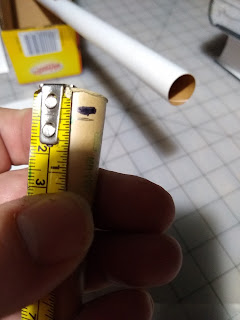The BlueJay Build -- Part 3

The Thrifty Rocketeer blog continues with part 3 of the BlueJay Build... Make a mark 1/4" from the end of the spent motor casing. This will be your limit mark. In the coming step, when inserting the motor block and glue, DO NOT push the spent motor casing in farther than this mark. This assures that you can grip the motor to pull it out quickly, AND that it will not be glued inside the body tube. Tie the motor block ring to the spent motor casing using an overhand knot or slip knot or two half hitches....whatever you like, as the next step will be to secure the knot with a drop of glue. Trim the loose stub of the Kevlar string off, and then remove the spent motor from the loop . This assures that the motor block ring is lassoed by the Kevlar, but is free to move about, trapped on the loop. The next step is to spread a band of glue 2 1/4" down inside the REAR END of the body tube. This band of glue will seize the motor block in the next motion when shoved into place by ...





